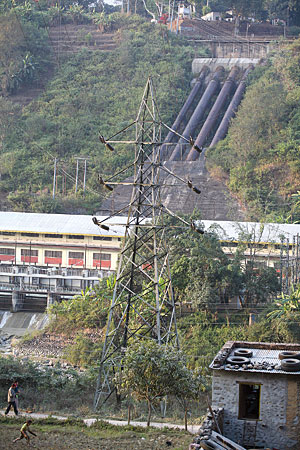 |
People in Bhutan must have felt magnanimous after reading the Times of India (ToI) article on June 20, 2009 that read: 'Bhutan PM pledges power aid for India'. For a tiny country like Bhutan to be able to 'aid' its giant neighbour India must be a thrill. Advocates of the Bhutan model in Nepal are also salivating at the possibility of wielding immense power (not electricity!) over India by exporting hydropower, in the hope that control will be in Nepali hands.
Of course, they will have forgotten that India will circumvent the possibility of Nepal controlling the flow of power by demanding that they get to ensure the 'security' of such projects, with Indian security personnel. The Karnali Chisapani project, meant to generate 10,800MW, was shelved in the mid-70s by the then Nepali government for this very reason.
These people have their collective heads in the sand for a couple of other reasons. Bhutan's example illustrates a few ground realities. Kuensel online, Bhutan's national English-language news portal, reported that "contrary to existing notions, a new study says it is economically more beneficial for Bhutan to supply power to its industries than export to India." The report details findings from the Bhutani Ministry of Economic Affairs and the royal audit authority, which note that the government makes a profit of Nu 64 million if it exports electricity to India, compared to a profit of Nu 152.8 million from tax receipts if it supplies 15 major national industries. Economic Affairs Minister Lyonpo Khandu Wangchuk was reported to have said, "Electricity is the only plentiful raw material that can be used by our industries to compete with external competitors by value adding on reasonably priced power." Ministry Secretary Dasho Sonam Tshering reportedly alluded to Norway, which "also used its hydropower to initially bankroll its industrial development through power intensive metallurgy and fertilizers".
The export-oriented model of hydropower development in Bhutan has threatened its own industrial development. As early as 2008, Zeenews.com reported that "a severe power shortage may hit Bhutan in view of new industries readying up to kick start operations even as India is banking on borrowing electricity from the Himalayan country by 2020." Bhutan Power Corporation Limited is reported to have confirmed this. Kuensel online echoed this anxiety in February 2010, suggesting setting up captive thermal power plants and in May 2010, even calling for the import of electricity from India.
Due to the unique geopolitical relationship between India and Bhutan, the three hydropower projects built so far, with a total capacity of 1,416MW, are owned by Bhutan but funded by India as a 60 per cent grant and a 40 per cent soft loan. But this 'inter-government model' has been found wanting by the Indian Government of late. The ToI last year noted that "The power ministry is getting the jitters over venture models for setting up hydel projects committed to Bhutan, with a view emerging that the amount of investments India will have to make at one go till 2020 under the present inter-government arrangement may adversely affect our budgetary provisions."
According to records of a recent meeting called by Indian power sector officials, India is committed to projects in Bhutan of 10,000MW by 2020. This will require fast-track investment of Rs 500 billion at
Rs 45 billion per year till 2020. The Indian Government, therefore, is endeavouring to drastically reconfigure the model so future projects are built with 70 per cent loan and 30 per cent grant. According to Kuensel online, the Bhutanese government has not yet agreed to this.
Under the current model, Bhutan seems to be profiting even by exporting power at a dirt cheap rate. But once the financing modality is turned on its head, the benefits to the Bhutanese economy will shrink by a magnitude. By exporting power, furthermore, it is condemned to remain underdeveloped.
For Nepal, with a population of 28 million, to reach the same level of 'gross national happiness' achieved under the current India-Bhutan inter-government model would require India to finance 52,864MW of electricity. Unfortunately, India is already experiencing financing fatigue after its relatively small investments in Bhutan. It's time for the hydrocracy in Nepal � the politicians, policymakers, planners, bureaucrats, and intelligentsia who deal in hydropower � to acknowledge the ground realities and grow out of their short-sighted, juvenile vision for Nepal's hydropower future.
Ratna Sansar Shrestha is a water resource analyst
READ ALSO:
'Nepal is not Bhutan', RATNA SANSAR SHRESTHA


